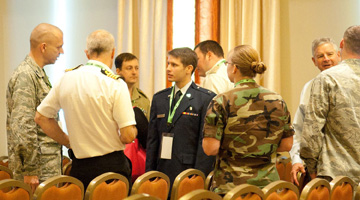New Treatments Improve Life for Injured Soldiers

When injuries occur on the battlefield, they can be debilitating. Soldiers are often faced with difficult and painful rehabilitation and some may never return to duty. Military medicine actively assumes the responsibility of caring for our Soldiers throughout their careers. As the injuries and threats change with the mission, so must our approach to treatment.
At the 2011 ATACCC Conference, attendees had the opportunity to learn about many new approaches to treating battlefield casualties. Two of those approaches are offering dramatic advances in treatment and improving return to duty rates.
Ablative Fractional Laser Treatments improve upon laser usage of the past to help reconstruct tissue and skin using a varying pulse, density, and depth to treat disfiguring and limiting injuries. This treatment can be done with minimal pain using fewer anesthesia. The results are: improved skin durability, range of motion, as well as a more natural and comfortable appearance. What is most impressive about this technique is the ability to treat the wound earlier and with less with time between treatment. This allows the Soldier to return to duty sooner or move on to working with prosthesis if they choose to do so.
Another treatment that is changing the face of military medicine is the Return to Run program. Many of those wounded in combat experience lower extremity trauma. These wounds frequently lead to severe vascular, neurologic and soft tissue damage, as well as contamination of the wound and the surrounding area. Furthermore, nerve injuries, chronic pain, and muscle loss complicate not only surgical management, but also rehabilitation. It is common for many Soldiers who experience wounds of this type to request amputation.
New orthotic options are changing that; the Intrepid Dynamic Exoskeletal Orthosis is an orthotic device that has been designed to meet the demands of combat. When combined with a high-intensity, sports medicine based rehabilitation program wounded Soldiers are able to normal function in a shorter amount of time. This is due in part to the start of treatment at an earlier point in time which begins for some while they are still in circular external fixation. A study conducted by Army researchers shows that patients found the IDEO to be very comfortable, cause minimal skin irritation, easily put on and taken off, easily kept clean, and very durable. Additionally the study, which was conducted with 13 Soldiers who originally requested amputation, found that after using the IDEO eight of those Soldiers chose to salvage the limb.














